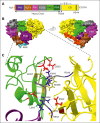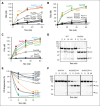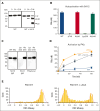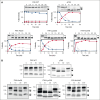A model of zymogen factor XII: insights into protease activation
- PMID: 39883942
- PMCID: PMC12018978
- DOI: 10.1182/bloodadvances.2025015842
A model of zymogen factor XII: insights into protease activation
Abstract
In plasma, the zymogens factor XII (FXII) and prekallikrein reciprocally convert each other to the proteases FXIIa and plasma kallikrein (PKa). PKa cleaves high-molecular-weight kininogen (HK) to release bradykinin, which contributes to regulation of blood vessel tone and permeability. Plasma FXII is normally in a "closed" conformation that limits activation by PKa. When FXII binds to a surface during contact activation it assumes an "open" conformation that increases the rate of activation by PKa. Mutations in FXII that disrupt the closed conformation have been identified in patients with conditions associated with excessive bradykinin formation. Using FXII structures from the AlphaFold database, we generated models for the closed form of human FXII that we tested with site-directed mutagenesis. The models predict multiple interactions between the fibronectin type 2 (FN2), kringle, and catalytic domains involving highly conserved amino acids that restrict access to the FXII activation cleavage sites. Based on the model, we expressed FXII with single-amino acid substitutions and studied their effects on FXII activation by PKa. Replacements for Arg36 in the FN2 domain; Glu225, Asp253, or Trp268 in the kringle domain; or Lys346 near the activation cleavage site were activated >10-fold faster by PKa than wild-type FXII. Adding these proteins to plasma resulted in rapid HK cleavage due to markedly enhanced reciprocal activation with prekallikrein. The results support a model that explains the behavior of FXII in solution. Conformational changes involving the identified amino acids likely occur when FXII binds to a surface to facilitate activation.
© 2025 American Society of Hematology. Published by Elsevier Inc. Licensed under Creative Commons Attribution-NonCommercial-NoDerivatives 4.0 International (CC BY-NC-ND 4.0), permitting only noncommercial, nonderivative use with attribution. All other rights reserved.
Conflict of interest statement
Conflict-of-interest disclosure: D.G. receives consultant fees from Anthos, Bayer, Bristol Myers Squibb, and Kanssen with an interest in inhibition of contact activation and the kallikrein-kinin system for therapeutic purposes. The remaining authors declare no competing financial interests.
Figures







Similar articles
-
Acinetobacter Baumannii Secreted Protease CpaA Inhibits Factor XII-Mediated Bradykinin Generation and Neutrophil Activation.Circ Res. 2025 Jun 20;137(1):e1-e15. doi: 10.1161/CIRCRESAHA.124.324764. Epub 2025 May 13. Circ Res. 2025. PMID: 40357548
-
Crystal structure of coagulation factor XII N-terminal domains 1-5.Acta Crystallogr D Struct Biol. 2025 Jul 1;81(Pt 7):380-393. doi: 10.1107/S2059798325005297. Epub 2025 Jun 27. Acta Crystallogr D Struct Biol. 2025. PMID: 40576968 Free PMC article.
-
Protease activity in single-chain prekallikrein.Blood. 2020 Feb 20;135(8):558-567. doi: 10.1182/blood.2019002224. Blood. 2020. PMID: 31800958 Free PMC article.
-
Proteolytic activity of contact factor zymogens.J Thromb Haemost. 2021 Feb;19(2):330-341. doi: 10.1111/jth.15149. Epub 2020 Dec 7. J Thromb Haemost. 2021. PMID: 33107140 Free PMC article. Review.
-
The effect of sample site and collection procedure on identification of SARS-CoV-2 infection.Cochrane Database Syst Rev. 2024 Dec 16;12(12):CD014780. doi: 10.1002/14651858.CD014780. Cochrane Database Syst Rev. 2024. PMID: 39679851 Free PMC article.
Cited by
-
A brief comparison of human factor XII-Ala188 and factor XII-Pro188.Res Pract Thromb Haemost. 2025 Jul 16;9(5):102957. doi: 10.1016/j.rpth.2025.102957. eCollection 2025 Jul. Res Pract Thromb Haemost. 2025. PMID: 40709223 Free PMC article. No abstract available.
References
-
- de Maat S, Maas C. FXII: form determines function. J Thromb Haemost. 2016;14(8):1498–1506. - PubMed
-
- Maas C, Renné T. Coagulation factor XII in thrombosis and inflammation. Blood. 2018;131(17):1903–1909. - PubMed
-
- Schmaier AH. The contact activation and kallikrein/kinin systems: pathophysiologic and physiologic activities. J Thromb Haemost. 2016;14(1):28–39. - PubMed
-
- Long AT, Kenne E, Jung R, Fuchs TA, Renné T. Contact system revisited: an interface between inflammation, coagulation, and innate immunity. J Thromb Haemost. 2016;14(3):427–437. - PubMed
MeSH terms
Substances
Grants and funding
LinkOut - more resources
Full Text Sources

